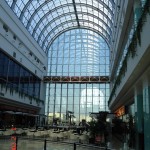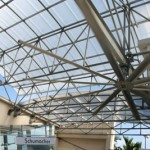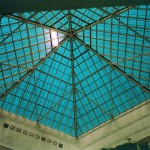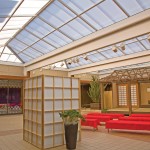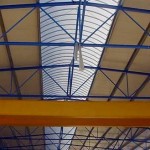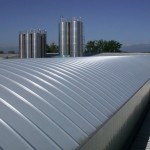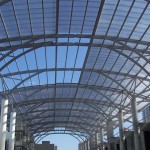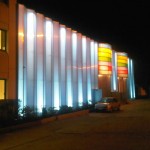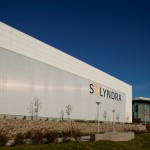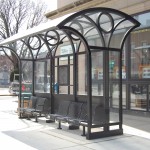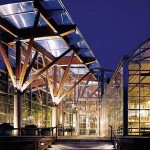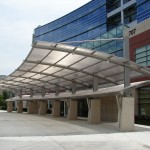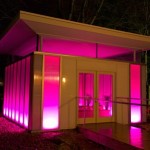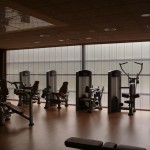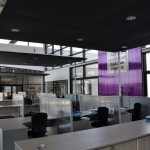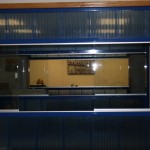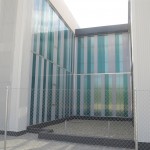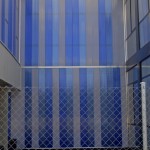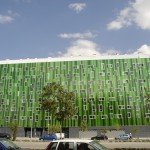Polycarbonate in Architecture, Engineering and Construction
Daylighting Opportunities
There are many reasons for the renewed interest in daylighting, the high cost of fossil fuels and the realization that sources of electricity have a finite life; perhaps even more important though are the less tangible aspects of daylighting which relate more to the human spirit, and the quality of life….
From office buildings to schools, manufacturing plants to hotels, daylighting plays an important role in a building’s design. The California Board for Energy Efficiency conducted a study (hyperlink that to the daylighting study PDF) that shows empirically that daylighting boosts everything from employee morale to student’s test scores, while decreasing the length of hospital stays and increasing retail traffic. Daylighting not only supports our efforts with sustainability, helps conserve energy resources but improves our overall productivity and well-being. The use of polycarbonate to enhance daylighting in architectural design is playing an ever-growing part in this movement to bring daylight into our lives.
Earn your AIA and USGBC learning credits by taking our continuing education course.
 |
Take our accredited AIA online course.
Click here to request an Online or Live presentation |
 |
Take our accredited GBCI online course. |
Horizontal Daylighting
Skylighting, when designed properly, will optimize the sun’s trajectory and maximize the amount of light coming into a building. The optimal area of skylights (usually quantified as “effective aperture”) varies according to climate, latitude, and the characteristics of the skylight, but is usually 4-8% of floor area. With proper skylight design, there can be significant energy savings in commercial and industrial applications. Savings from daylighting can cut lighting energy use by up to 80 percent according to the US Department of Energy’s Federal Energy Management Program. In terms of cost savings, the DOE reported that many commercial buildings can reduce total energy costs by up to one-third through the optimal use of daylighting. Gallina USA has designed a myriad of products that offer the architect or designer a wide variety of panels and sheets that can be customized with color or coextruded with a number of glazing options intended to improve thermal performance and efficiency. Today’s skylight fabricators are taking full advantage of the wide variety of Gallina PoliCarb® and arcoPlus® products and designing them into their skylight systems. Products ranging in thickness from 10mm -40mm extruded in colors that both enhance appearance and improve thermal efficiency, combined with our unique IR® coextrusion, make the decision to incorporate polycarbonate into a skylight system an easy one.
Vertical Daylighting
Another important element in creating daylighting is the use of clerestory windows. These are high, vertically-placed windows. They can be used to increase direct solar gain when oriented towards the equator. When facing toward the sun, clerestories and other windows may admit unacceptable glare. In the case of a passive solar house, clerestories may provide a direct light path to polar-side (north in the northern hemisphere; south in the southern hemisphere) rooms that otherwise would not be illuminated. Alternatively, clerestories can be used to admit diffuse daylight (from the north in the northern hemisphere) that evenly illuminates a space such as a classroom or office.
Often, clerestory windows will shine onto interior wall surfaces painted white or another light color. These walls are placed so as to reflect indirect light to interior areas where it is needed. This method has the advantage of reducing the directionality of light to make it softer and more diffuse, reducing shadows. With these needs in mind Gallina has designed a series of panels and systems for vertical window and clerestory applications. Depending on climate, geography, or application our arcoPlus® line includes tongue and groove panels from 20mm -40mm thick and in various widths; as well as standing seam modular panel systems from 8mm -20mm thicknesses that will offer the architect/designer a wide variety of choices to meet the needs of their project.
Design Opportunities
In the early years of the 20th century, Chicago architect Louis Sullivan popularized the phrase ‘form ever follows function’ to capture his belief that a building’s size, massing, spatial grammar and other characteristics should be driven solely by the function of the building. The implication is that if the functional aspects are satisfied, architectural beauty would naturally and necessarily follow. Today’s architects are incorporating polycarbonate in ways that are not only functional but beautiful and practical
Branding
Gallina USA has worked closely with designers of hotel chains, retail establishments and in conjunction with our customers has worked to enhance particular brands by virtue of accentuating those companies building designs (interior and exterior) through the use of color and panel design.
Applications
There are so many options available when considering where to incorporate polycarbonate into your design.
Some of these include:
Color & Texture
According to María L. F. de MATTIELLO, “….. Physically speaking color and light belong to a single radiant spectrum so, without light color cannot exist.” Color can enhance design and be functional at the same time. Combining color in design while taking advantage of light only makes sense.
Performance
No project where daylighting is being incorporated is done without consideration of performance and energy cost savings. Today’s energy modeling software programs are able to calculate energy savings when incorporating daylighting systems into a building. Gallina USA has developed products for vertical applications with R-values exceeding 5.0 and with our IR® technology are able to reduce Solar Heat Gain Coefficients (SHGC) to below 30 on some profiles. Variable light transmission, light diffusion, reduced acoustical transmissions, improved thermal performance, all good reasons to integrate Gallina panels into your next design.
Solar Control
The control of the temperature and the management of heat are essential elements in maintaining a desired level of comfort within buildings. They are also critical elements for controlling cost and maximizing energy savings. Gallina’s engineers work with many of the world’s cutting edge companies in developing solutions for solar control. Click on these links for information on IR®; AR; Caleido®; Orange Peel; and Reflecto
Gallina USA’s role in Daylighting
Industrie Materie Plastiche Dott. Gallina Srl was founded in 1960 by Pier Aulo Gallina, originally to manufacture profiles for the automotive industry. With developments in technology and the expansion of the market for thermoplastic materials, Gallina extended its range of products to supply the construction industry and is now a leading name in the international market. The company currently has a workforce of over 175 people and production plants in Italy, Greece, Poland, the US and India with several sales offices throughout Europe and the U.S.. Gallina manufactures plastic profiles for the automotive sector and multiwall sheets, solid sheets and modular polycarbonate panels for roofing and glazing applications in the construction industry.
These products are rapidly gaining acceptance in the U.S. marketplace due to their optical properties, which are similar to that of glass, and their superior mechanical and thermal characteristics. Gallina is at the forefront of this development. We are committed to a policy of advanced technological research, engineering excellence, and investment in leading-edge equipment. Gallina’s development of our modular panel arcoPlus® line is a testament to our commitment to advanced design and development.







